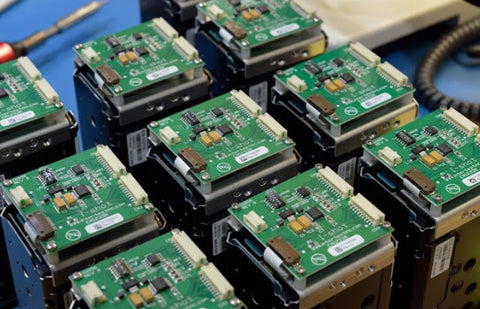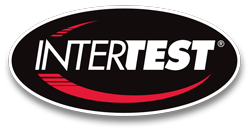The Zoom Block Camera is a powerful, high-resolution, and flexible camera that can be used for a wide range of industrial vision applications. Some of the most valuable zoom block camera features are their various video output signals these cameras are designed to produce. This article's purpose is to educate industrial camera users on the differences in the video output signals of zoom block cameras, and their best use-cases in industrial vision applications.
Zoom Block Camera Basics and Video Signals
All zoom block camera models are considered orignal equipment manufacturer (OEM) components. This means the cameras require integration with other components and parts before operation. To get a zoom block camera functioning usually require a robust, protective housing with mount options, and, most importanly, an interface board to provide power and communication to the camera.
Interface boards unlock the true potential of the many zoom block camera features. These features give the camera its versatility: motorized optical zoom lens, shutter speed, exposure, gain, and day/night options to name a few. These same interface boards are pushing and converting the video output signals from the zoom block cameras into a viewable format.

Pictured: Sony FCB Block Cameras with mounted interface boards.
Here are common video output signals for zoom block cameras:
CVBS
CVBS stands for Composite Video Baseband Signal. Not a digital signal like LVDS, the CVBS is an analog signal once commonly used in the entertainment industry's equipment. It can be transmitted over greater distances than digital signals in most cases, but CVBS does not have high resolutions like digital signals. Even though the demand for CVBS is dwindling, analog video occurs in many exisiting zoom block camera systems out in the industrial inspection field, so there is a legacy demand for this signal.
LVDS
Also known as Low Voltage Differential Signaling, LVDS is a digital signal used to transfer high-definition video over long distances with minimal latency, making it ideal for applications such as fixed-position surveillance or automatic license plate recognition (ALPR).
Sony FCB Block Cameras and KT&C Block Cameras both use LVDS technology, and with compatible interface boards, they transmit data from the zoom block camera to the monitor or DVR system.
Parallel
Parallel digital interface signal is used to connect zoom block cameras in sequence to computer systems, networks or multiple monitors. Parallel supports 8~16-bit data bus, with simultaneous HSYNC and VSYNC signals for frame synchronization. This signal is used to create a network of cameras for applications in surveillance, production inspection systems, and police vehical dashboards to name a few.
HDMI
HDMI (High Definition Multimedia Interface) is a standard for high-definition digital, uncompressed video transmission. It is well known in consumer electronic devices, such as a Blu-ray players or video game consoles, to a television or other audio/video receivers. HDMI uses only one cable and supports uncompressed audio and video signals, so it's ideal for connecting devices that require high-quality sound and picture. This signal is commonly used in that most commercially available monitors will display it.
The HDMI interface supports standard, enhanced and high definition resolutions up to 1080p (1,920 x 1,080 pixels). Although having the ability to carry this high resolution video, HDMI cannon extended beyond lengths of 50 feet without signal amplification.
3G-SDI
3G-SDI is a serial digital interface that can be used to carry uncompressed HD video signals over greater distances than HDMI signals. 3G-SDI uses four twisted pairs of copper wire to transmit up to 2970 Mbit/s data transfer bandwidth, allowing for 1080p/60 high definition video formats. Considered broadcast quality, 3G-SDI can be transmitted up to 100 feet over coax cabling, and up to 1,000 feet over optical fiber. Longer transmission cables for video signal can be useful in robotic vision systems such as underwater ROVs and bomb disposal robots.
6G-SDI
6GSDI is a higher-speed serial digital interface version of 3G-SDI. Up to 6000 Mbit/s data transfer bandwidth, 6G-SDI supports up to 1080p/120 HD video format, and 2160p/30 4K video format. This signal will transmit and allow for 4K video display when the need for high-resolution imaging occurs in industrial applications.
USB 3.0
USB 3.0 is a high-speed serial bus standard designed to connect peripheral devices to a host computer. USB 3.0 has a maximum signaling rate of 5000 Mbit/s data transfer, which is more than 10 times faster than its predecessor's USB 2.0's 480 Mbit/s. USB 3.0 high rate of video and data transfer allows for higher resolution video streaming. Transmitting directly from a zoom block camera to a computer has its advantages as a computer can display the video signal as well as act as the controlling interface for the zoom block camera.
Zoom Block Camera Models
Sony FCB Block Cameras
Pioneers of the Zoom Block Camera, Sony® has a selection of Full-HD and 4K models with various video ouputs such as outputs are LVDS, CVBS, and HDMI. Sony FCB block cameras have multiple video outputs and need interface boards for video/communication/power.
KT&C Block Cameras
KT&C Block Cameras have a large selection of Zoom Block Cameras in 4K and Full HD, as well as options between global and rolling shutters. KT&C block cameras offer a variety of video outputs such as HDMI, LVDS, CVBS and USB3.0.
- KT&C ATC-UZ5707U-H 4K HDMI Block Camera
- KT&C ATC-HZ5536W-LP Global Shutter Camera
- KT&C ATC- HZ5240T-LP 40x Rolling Shutter Camera
Interface Boards
Zoom Block Cameras require interface boards to control and send video signals. Individual cameras have compatible interface boards on their individual product pages.
Can't find a camera or interface board, or have questions on what is the best for you application? Let us help you! Contact InterTest's experience remote visual inspection sales team today!

